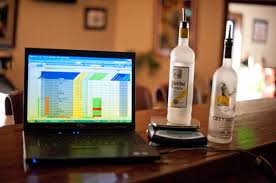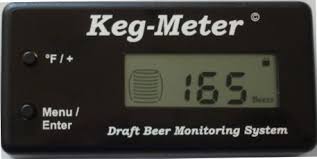Bar-i is proud to have been featured in the June 2017 issue of Bar Business Magazine. The article, titled “How to Maximize Your Pours and Profits,” highlights the innovations of three different up-and-coming bar inventory companies, including Bar-i. Our co-founder and co-owner, Jamie Edwards, was quoted in the article several times.
 While it’s always exciting to get positive coverage in a magazine article, we feel the most important takeaway from this article is that it provides some genuinely excellent insights that can help a bar owner to better understand the benefits of using a more sophisticated inventory system.
While it’s always exciting to get positive coverage in a magazine article, we feel the most important takeaway from this article is that it provides some genuinely excellent insights that can help a bar owner to better understand the benefits of using a more sophisticated inventory system.
Their Pro Tip (highlighted in an orange box on the bottom of the first page) underscores one of the most important benefits of losing the clipboard: “Put away the pen and paper and look into a software system that reduces the amount of time it takes you to complete your inventory.” You have to count inventory before you can analyze data to leverage it in a way that will improve your business.
Even if a bar chooses to work with a competitor of ours, it’s still crucial that they take the extra step to start using sophisticated inventory software. It’s become clear that manual in-house inventory efforts won’t provide the efficiency or accuracy of information you need to leverage your inventory efforts as a profitability tool. This technology exists, so you may as well take advantage of it to improve your bar’s operations.
Bar Inventory Software is Still in Its Infancy
 We’re still in the early stages of the inventory software life cycle, and many bars have been slow to adopt this new technology. This slow adoption rate is very similar to what occurred with POS systems about 20 years ago. Back then, no one used POS systems. Today, very few profitable bars are running their business without a POS system. Over time, bar owners came to recognize the important ways these systems helped streamline their operations and improve profitability, which ultimately led to the widespread adoption of POS systems throughout the bar industry.
We’re still in the early stages of the inventory software life cycle, and many bars have been slow to adopt this new technology. This slow adoption rate is very similar to what occurred with POS systems about 20 years ago. Back then, no one used POS systems. Today, very few profitable bars are running their business without a POS system. Over time, bar owners came to recognize the important ways these systems helped streamline their operations and improve profitability, which ultimately led to the widespread adoption of POS systems throughout the bar industry.
In many ways, bar inventory technology is experiencing the same level of acceptance that POS systems experienced in their infancy. Approximately 50% of bars are still implementing some sort of in-house inventory system that involves using a pen and paper, clipboards and Excel spreadsheets that need to be updated manually. As more bar owners start to recognize the benefits of inventory software, these systems will most likely start to become standard in most bars, just as POS systems have become standard.
Hopefully articles like this one will help bar owners who have been hesitant to embrace this technology recognize that it can significantly benefit their bar.
Key Takeaways from the Article
The article clearly explains some of the most important benefits achieved by using modern inventory software. They can help you improve the way you perform the critical tasks associated with inventory, such as:
- Counting inventory values (modern inventory systems will do this in much less time than manual in-house practices)
- Calculating liquor cost (most sophisticated systems will do this for you)
- Assisting with weekly orders (most modern inventory systems will automate this process for you)
These are the basic functions accomplished by the inventory process, but there are still a lot of bars that don’t even make this a part of their regular operations. At Bar-i, we’re amazed by how many bar owners we speak with during consultations that don’t know their liquor cost on a consistent basis. This is a big problem, and it can potentially result in leaving a significant amount of profits on the table.
Liquor cost is essentially a measure of financial efficiency. By definition, liquor cost tells you how many cents are spent purchasing a particular liquor product for every dollar of sales generated by that product. For example, if you have a liquor cost of 20%, it means that for every dollar of sales, you spend 20 cents buying the product. In real world terms (since drinks never cost $1), it means that for a drink costing a customer $6, you spent $1.20 purchasing the liquor used in that drink.
Having a lower liquor cost will equate to a higher profit margin on your drinks. Therefore, knowing your liquor cost is a simple way to determine how efficient you are with your use of product.
The Key Players in the Article – BevSpot, Bar-i and KegSafe
The article starts out discussing the services provided by BevSpot, an inventory company started by Rory Crawford 3 years ago. Rory’s company BevSpot provides an excellent service that is helping to move the inventory industry forward.
 Rory talks about analyzing the data collected in order to get more out of your inventory efforts than simply achieving the basic tasks discussed above (calculate inventory values, calculate liquor cost and tell you what needs to be ordered each week). This additional data analysis will help you use your inventory efforts as a profitability tool. The extra data analysis step is also what Bar-i provides.
Rory talks about analyzing the data collected in order to get more out of your inventory efforts than simply achieving the basic tasks discussed above (calculate inventory values, calculate liquor cost and tell you what needs to be ordered each week). This additional data analysis will help you use your inventory efforts as a profitability tool. The extra data analysis step is also what Bar-i provides.
These services are highly valuable, but it’s not quite as simple as matching inventory up to sales. It takes a sophisticated level of analysis that can’t be fully automated. Instead, it requires a dedicated inventory professional to assist with the process. What makes companies like BevSpot and Bar-i stand out from other services which automate the entire process is that we provide this active management of the entire inventory process.
Like Bar-i, BevSpot thinks about inventory on-hand in terms of past usage in order to create dynamic pars that will make your ordering more accurate. Both systems look at what you use per day and how many days’ worth of product you have on-hand in order to build out an effective order guide.
Simpler systems often use a fixed par to guide ordering. For example, 6 bottles of Jack Daniels will need to be on-hand at all times, and your ordering will be based on this arbitrary fixed par. The problem with this method is that it’s not based on data. Having a system like Bar-i or BevSpot which uses data-driven dynamic pars that update automatically as your customers’ usage of each product changes will be more useful to you and ensure you always have the correct amount of product on-hand at all times.
Using dynamic pars will help you reduce inventory on-hand, which is always a good goal. It frees up working capital for the business and reduces financial risk by avoiding a situation where thousands of dollars of extra product are sitting around unused.
Rory’s assertion that most bars can lower their inventory on-hand is definitely true, but we feel his estimates are somewhat conservative. In general, we recommend that most bars should keep four times what they use per week on-hand. In some instances, such as with very high performing bars, this figure can even drop as low as three times what they use per week on-hand.
Ultimately, implementation is a huge part of providing inventory services. It’s why companies that offer full service solutions exist and are achieving a great deal of success with the bars they work with.
Bar-i offers a full service option in addition to the more affordable hybrid inventory service option. This allows bar owners to choose the right option for their unique business model, and it’s a key point of differentiation between Bar-i and many of the other services available.
Bar-i’s full service and hybrid options both provide a dedicated inventory expert to help you with the analytics data we generate. Our inventory expert will work with you to ensure you understand how to leverage this data in a way that allows you to move beyond using inventory for the three basic tasks so that you can gain deeper insights into the performance of your bar.
 Another differentiator is Bar-i’s use of scales to count inventory. The upside of weighing bottles is speed and accuracy:
Another differentiator is Bar-i’s use of scales to count inventory. The upside of weighing bottles is speed and accuracy:
- Each bottle can be weighed in less than 2 seconds, and this value is automatically entered onto your inventory spreadsheet for you, eliminating the potential for data transfer errors
- Bar-i’s scales are accurate to the hundredth of an ounce, ensuring that all inventory values are calculated down to the serving
Apps such as BevSpot aren’t using any hardware with their service. While these systems allow you to get up and running instantly and have lower setup costs without hardware such as a scale, you’re sacrificing the precision and speed achieved when you count inventory by weighing bottles.
KegSafe, the third company profiled in the Bar Business Magazine article, offers interesting technology to accurately determine how much beer is left in a keg. This inventory service is brand new, and so time will tell whether they provide a more effective system than other automated draft beer inventory systems. It’s extremely new technology (it doesn’t even launch until August 2017), so it’s not yet clear whether it will easily allow bars to match usage with sales. This is the crucial step necessary to determine the performance of your draft beer products.
In the article, KegSafe CEO Mark McCoy explains how the transducer technology used by KegSafe is more accurate than using scales or flow meters to calculate the amount of beer in a keg. This may be true, but the fact remains that both scales and flow meters are highly accurate to the level where they can provide the precision necessary to determine how much of each draft beer product is missing.
The benefits of using scales to take inventory for bottles discussed above hold true for kegs as well. As a result, this remains Bar-i’s preferred method of counting draft beer inventory.
 While flow meters are highly accurate, they present challenges in terms of matching usage to sales because they require constant maintenance and calibration:
While flow meters are highly accurate, they present challenges in terms of matching usage to sales because they require constant maintenance and calibration:
- If you change the beer, you have to recalibrate the flow meter so that it tracks that new beer correctly
- When you change lines, sometimes you need to update the flow meter to indicate that you just tapped a new keg
- When your line cleaner comes, the flow meter will measure the flow of the cleaning fluid used so you’ll need to back that info out of your data
This technology provides some great benefits, but it falls short in its ability to match this usage data with your sales data since it’s a fully automated system, and matching this data requires a real life person. We haven’t found a fully automated system that will tell you how many servings are missing on a consistent basis without recalibrating and updating the flow meter. If you’re changing beers every week or every day, someone is going to have to tell the system which beer is currently in use in order to achieve accurate results.
Bar Inventory is Entering the 21st Century
Articles such as this one from the most recent issue of Bar Business Magazine clearly highlight that the technology is now available to automate your inventory efforts. Ultimately, these modern inventory systems can pay big dividends for your bar.
One important point to keep in mind is that while the article primarily focuses on the time savings associated with modern inventory software, the bigger benefit you’ll receive when you upgrade your inventory system is the ability to reduce shrinkage and leverage your inventory efforts as a profitability tool. Services such as Bar-i and BevSpot allow you to accomplish this goal by taking the extra step of matching usage data with sales data to determine precisely what’s missing each inventory period.
If you’re going to spend time taking inventory, shouldn’t you receive the maximum benefits possible from these efforts? When you consider the amount of money you can save by reducing shrinkage, it becomes a no-brainer to lose the clipboard and start using the most advanced inventory technology available.
If you’d like to learn more about how Bar-i can help you improve your bar’s operations and maximize profits, please contact us today to schedule a free consultation. We serve clients nationwide from our offices in Denver, Colorado.


-1.png)